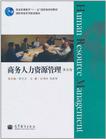商务人力资源管理
2011-5
高等教育
彭朝林//徐新辉|主编:徐小贞
253
《商务人力资源管理(英文版)》的编写借鉴英国国家职业资格证书(NVQs)教育科学的教学指导思想、先进实用的育人理念、以学生为中心的教学方法、模块化的教学方式、重在过程的多元化教学评估、强调核心技能的素质教育实践,从选材、体例到评估都体现了国际上先进的职业教育理念。
Part I For StudentsChapter I Introduction to Human ResourceManagement1.1 What Is Human Resource Management?1.2 HRM Functions1.3 The Changing Environment of HRM1.4 The Changing Role of HRM1.5 Strategic Human Resource Management1.6 Competencies of the Human Resource ManagerChapter 2 Career Planning2.1 Self Development2.2 Roles in Career Development2.3 Factors That Affect Career Choices2.4 Becoming an Entrepreneur: Four Steps to EntrepreneurshipChapter 3 Job Analysis3.1 What Is Job Analysis?3.2 Writing Job Descriptions3.3 Writing Job Specifications3.4 Job DesignChapter 4 Human Resource Planning4.1 Strategic Human Resource Planning4.2 Stages of Human Resource Planning4.3 Reasons for Human Resource Planning4.4 How to Forecast Personnel Needs4.5 Forecasting the Supply of Inside Candidates4.6 Succession PlanningChapter 5 Recruiting Employees5.1 Recruiting5.2 Labor Ma,'kets5.3 Strategic Recruiting Stages5.4 Recruiting Source Choices: Internal vs. External5.5 Recruiting Over the InternetChapter 6 Selecting Employees6.1 The Importance of Selection6.2 The Nature of Selection6.3 Environmental Factors Influencing Selection6.4 Basic Requirements of Selection6.5 Selection Process6.6 Employment Tests6.7 Reference Checks and Recommendations6.8 Physical ExaminationsChapter 7 Training Employees7.1 Employee Orientation7.2 The Training Process7.3 Training Needs Analysis7.4 Training Techniques7.5 Creative Training Over the InternetChapter 8 Permance Appraisal8.1 The Performance Appraisal Process8.2 Why Appraise Performance?8.3 Methods for Appraising Performance8.4, Performance Appraisal: Problems and Solutions8.5 How to Avoid Appraisal ProblemsChapter 9 Organizational Renewal9.1 Organizational Change and Development9.2 HRM and Total Quality Management9.3 How HR Helps to Create Team-based Organizations9. 4 How HR Helps to Build Productive Teams9.5 What Is Business Process Reengineering?9.6 Flexible Work ArrangementsPart Ⅱ For Teachers
版权页:插图:4.4.2 Ratio AnalysisRatio analysis is a forecasting technique for determining future staff needs by usingratios between sales volume and number of employees needed.Ratio analysis means making forecasts based on the ratio between (1) some causalfactor ( like sales volume) and (2) number of employees required ( for instance, number ofsalespeople). For example, suppose you find that a salesperson traditionally generates $500, 000 in sales. Then, if the sales revenue-salespeople ratio remains the same, you wouldrequire six new salespeople next year (each of whom produces and extra $500, 000 in sales)to produce the hoped-for extra $3 million in sales.Like trend analysis, ratio analysis assumes that productivity remains about the same——forinstance, that each sales person can't be motivated to produce much more than $500, 000 insales each. If sales productivity were to increase or decrease, then the ratio of sales tosalespeople would change. A forecast based on historical ratios would then no longer be asaccurate.
《商务人力资源管理(英文版)》是普通高等教育“十一五”国家级规划教材,国际商务系列英语教材之一。
